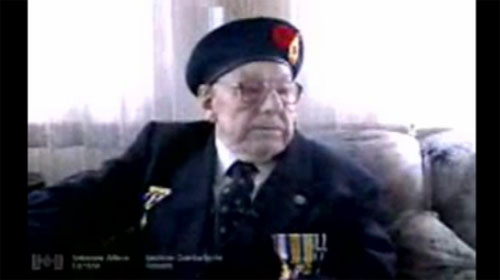Battle of Vimy Ridge
Heroes Remember
Battle of Vimy Ridge
Transcript
We didn't know what they were doing. (No.)
What they were preparing for.
Interviewer: But you knew something was up. (Oh Yeah).
Something big. Oh yeah. Till Easter morning
Interviewer: Can you tell me about it?
Pouring raining. You could see why we trying,
the boys are climbing on their hands and knees. (Yes)
white/grey stones, slippery
Interviewer: Now you're showing me an article or
you're referring to an article that has a picture
and your, and you believe that's a picture of
your machine gun group.
I was NCO of the machine gun. (Yes.)
Trench machine gun. (Yes sir.)
Light machine gun, that's what we called
them and, and I had been warned by
my officer to watch for a counter attack (Yes.)
and I got it and I got right stern with,
I got on, on, on the Germans coming.(Okay.)
Whole platoon of them.
Interviewer: So this, this attack then that
you beat off was after you'd taken
Vimy Ridge was it? The what?
Interviewer: Vimy Ridge had already been
taken Mr. Downey and?
Oh they were, oh yeah, my boys were,
they brought up 6, 7 machine guns.
The Germans had in there and
the rest of it were just like a living
quarter for officers. (Okay.)
You talk about French furniture and every,
liquor but we did not touch it.
They might poison it, see.
And soon, our fellows got up on that
ladder we got, fired a few bombs in there.
That was it.
Interviewer: Well, tell me about
how the attack began.
You said it started off, it was raining?
They sneaked up on them (inaudible) and
they couldn't and once,once they got
there see they had rabbit holes.
They got the rabbit holes alot I suppose
for ventilation in there. (Yes.)
They got so they could fire them good aim
right now and put it (inaudible)
machine gun and let her go.
Oh Christ, they were practically all dead. (Okay.)
We got a few live one but. (Okay.)
And then after, after we tore the top,
big hole on the top of that so we could
get down and see what they had in
there and sort them out.
The dead ones check them over to them
to the other side and the live ones,
chuck them outside, prisoners.
Interviewer: Okay. And did you take
many prisoners that day?
Not very many out of that. (No.)
There was a few officers,
I think right the first bomb that dropped a
few officers come out (inaudible)
one of their vent holes, and over
the top hollered something to us.
Said the commanding officer leading the attack
"Put your hands up" and then when we got
down there, we found a few.
A few alive, most them were dead.
Suffocate from the smoke from and
one of those hand grenades if it was thrown
in to a place like that it would kill 7 or 8 men.
(Yes.) It blows up in little squares.
See the bomb itself is all corrugated everywhere.
When it goes off it all breaks up in pieces. (Yes.)
Each piece will kill a man.
Interviewer: Do you remember what the
reaction was at, at, at the time that the
Canadians took the, the top of the heights?
When they secured the position?
The reaction, the reaction was they took
a few hours to get them sorted out and
get them cleaned out of there.
And take the prisoners back,
we had a bunch detailed take the prisoners
back and the dead ones we fired over on
their side and we cleaned the place
up and we stayed there. We stayed there!
That was our orders. And, and we used it as,
all of what, the officers a lot of the officers
it was used as sleeping quarters.
It was a regular home. (Yes.)
Dug out of the, that bank.
Interviewer: Did you have any, any feeling at
the time of how important a victory that was?
Well it big talk. It was big talks about it
when the French failed and then the British
failed and lost so many men. We, we did go.
We had hundreds, that's what we were,
they were up to and we were (inaudible)
loses and everything but we wasn't sure.
And we said another, another ten,
ten thousand our men gone,
but we lost a lot of men but we took it and
held it and they never tried to come back.
Well, they couldn't. (No.)
No, we were watching them all the time. (Yes.)
But we, we took them by surprise.
Description
Mr. Downey recalls his participation in the historic Battle of Vimy Ridge on Easter Monday, April 9, 1917.
Philip Downey
Philip Downey was born on January 28, 1891 in Shemogue, New Brunswick. His father was a carriage-maker and a farmer. When the First World War began, Mr. Downey was working in an automobile factory in Amherst, Nova Scotia. In the Autumn of 1914, he enlisted in the 26th Battalion of the Canadian Expeditionary Force. Following basic training in Saint John, New Brunswick, he sailed to England for further training. Late in the autumn of 1915, he joined the Canadian troops in France, attached to the 5th Brigade. Mr. Downey was 105 years old when he was interviewed in 1996.
Meta Data
- Medium:
- Video
- Owner:
- Veterans Affairs Canada
- Duration:
- 05:12
- Person Interviewed:
- Philip Downey
- War, Conflict or Mission:
- First World War
- Battle/Campaign:
- Battle of Vimy Ridge
- Branch:
- Army
- Units/Ship:
- 26th Battalion, Canadian Expeditionary Force
- Rank:
- Non-Commissioned Officer (NCO)
Related Videos
- Date modified:




